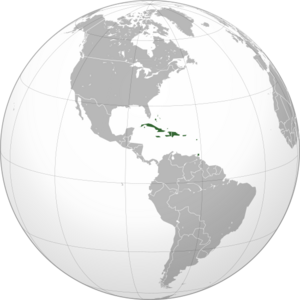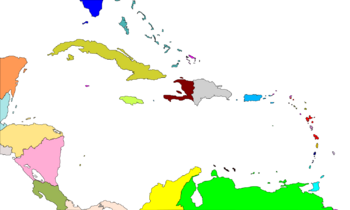West Indies facts for kids
The West Indies is a subregion of North America, surrounded by the North Atlantic Ocean and the Caribbean Sea, which comprises 13 independent island countries and 19 dependencies in three archipelagos: the Greater Antilles, the Lesser Antilles, and the Lucayan Archipelago.
The subregion includes all the islands in the Antilles, in addition to The Bahamas and the Turks and Caicos Islands, which are in the North Atlantic Ocean. Nowadays, the term West Indies is often interchangeable with the term Caribbean, although the latter may also include coastal regions of Central and South American mainland nations, including Mexico, Belize, Panama, Colombia, Venezuela, French Guiana, Guyana, and Suriname, as well as the Atlantic island nation of Bermuda, all of which are geographically distinct from the three main island groups, but culturally related.
Contents
Origin and use of the term
The English term Indie is derived from the Classical Latin India, a reference to the territories in South Asia adjacent and east to the Indus River. India itself derived successively from Hellenistic Greek India ( Ἰνδία), ancient Greek Indos ( Ἰνδός), Old Persian Hindush (an eastern province of the Achaemenid Empire), and ultimately its cognate, the Sanskrit Sindhu, or "river", specifically the Indus River and its well-settled southern basin. The ancient Greeks referred to the Indians as Indoi (Ἰνδοί), which translates as "The people of the Indus".
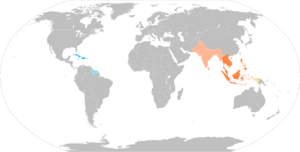
In 1492, Christopher Columbus and his Spanish fleet left Spain seeking a western sea passage to the Eastern world, hoping to profit from the lucrative spice trade emanating from Hindustan, Indochina, and Insulindia, the regions currently found within the Indian Subcontinent and Southeast Asia, which were first simply referred to by Spanish and Portuguese explorers as the Indias (Indies).
Thinking he had landed on the easternmost part of the Indies in the Eastern world when he came upon the New World, Columbus used the term Indias to refer to the Americas, calling its native people Indios (Indians). To avoid confusion between the known Indies of the Eastern Hemisphere and the newly discovered Indies of the Western Hemisphere, the Spanish named the territories in the East Indias Orientales (East Indies) and the territories in the West Indias Occidentales (West Indies). Originally, the term West Indies applied to all of the Americas.
The Indies from both regions were further distinguished depending on the European world power to which they belong. In the East Indies, there were the Spanish East Indies and the Dutch East Indies. In the West Indies, the Spanish West Indies, the Dutch West Indies, the French West Indies, the British West Indies, and the Danish West Indies.
The term was used to name the Spanish Council of the Indies, the British East India Company, the Dutch East India and West India companies, the French East India Company, and the Danish East India Company.
History
Many cultures were indigenous to these islands, with evidence dating some of them back to the mid-6th millennium BCE.
In the late 16th century, French, English and Dutch merchants and privateers began operations in the Caribbean Sea, attacking Spanish and Portuguese shipping and coastal areas. They often took refuge and refitted their ships in the areas the Spanish could not conquer, including the islands of the Lesser Antilles, the northern coast of South America, including the mouth of the Orinoco, and the Atlantic Coast of Central America. In the Lesser Antilles, they managed to establish a foothold following the colonisation of Saint Kitts in 1624 and Barbados in 1626, and when the Sugar Revolution took off in the mid-17th century, they brought in thousands of enslaved Africans to work the fields and mills as labourers. These enslaved Africans wrought a demographic revolution, replacing or joining with either the indigenous Caribs or the European settlers who were there as indentured servants.
The struggle between the northern Europeans and the Spanish spread southward in the mid to late seventeenth century, as English, Dutch, French and Spanish colonists, and in many cases, enslaved Africans first entered and then occupied the coast of The Guianas (which fell to the French, English and Dutch) and the Orinoco valley, which fell to the Spanish. The Dutch, allied with the Caribs of the Orinoco, would eventually carry the struggles deep into South America, first along the Orinoco and then along the northern reaches of the Amazon.
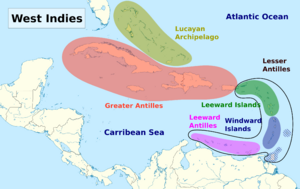
Since no European country had occupied much of Central America, gradually, the English of Jamaica established alliances with the Miskito Kingdom of modern-day Nicaragua and Honduras and then began logging on the coast of modern-day Belize. These interconnected commercial and diplomatic relations comprised the Western Caribbean Zone in place in the early-18th century. In the Miskito Kingdom, the rise to power of the Miskito-Zambos, who originated in the survivors of a rebellion aboard a slave ship in the 1640s and the introduction of enslaved Africans by British settlers within the Miskito area and in Belize, also transformed this area into one with a high percentage of persons of African descent as was found in most of the rest of the Caribbean.
From the 17th through the 19th century, the European colonial territories of the West Indies were the French West Indies, British West Indies, the Danish West Indies, the Netherlands Antilles (Dutch West Indies), and the Spanish West Indies.
In 1916, Denmark sold the Danish West Indies to the United States for US$25 million in gold, per the Treaty of the Danish West Indies. The Danish West Indies became an insular area of the U.S., called the United States Virgin Islands.
Between 1958 and 1962, the United Kingdom re-organised all their West Indies island territories (except the British Virgin Islands and the Bahamas) into the West Indies Federation. They hoped that the Federation would coalesce into a single, independent nation. However, the Federation had limited powers, numerous practical problems, and a lack of popular support; consequently, it was dissolved by the British in 1963, with nine provinces eventually becoming independent sovereign states and four becoming current British Overseas Territories.
"West Indies" or "West India" was a part of the names of several companies of the 17th and 18th centuries, including the Danish West India Company, the Dutch West India Company, the French West India Company, and the Swedish West India Company.
West Indian is the official term used by the U.S. government to refer to people of the West Indies.
The term survives today mainly through the West Indies cricket team, representing all of the nations in the West Indian islands.
Geology
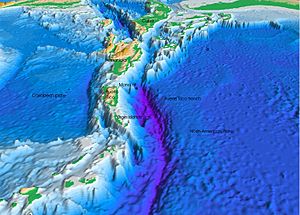
The West Indies are a geologically complex island system consisting of 7,000 islands and islets stretching over 3,000 km (2000 miles) from the Florida peninsula of North America south-southeast to the northern coast of Venezuela. These islands include active volcanoes, low-lying atolls, raised limestone islands, and large fragments of continental crust containing tall mountains and insular rivers. Each of the three archipelagos of the West Indies has a unique origin and geologic composition.
Greater Antilles
The Greater Antilles is geologically the oldest of the three archipelagos and includes both the largest islands (Cuba, Jamaica, Hispaniola, and Puerto Rico) and the tallest mountains (Pico Duarte, Blue Mountain, Pic la Selle, Pico Turquino) in the Caribbean. The islands of the Greater Antilles are composed of strata of different geological ages including Precambrian fragmented remains of the North American Plate (older than 539 million years), Jurassic aged limestone (201.3-145 million years ago), as well as island arc deposits and oceanic crust from the Cretaceous (145-66 million years ago).
The Greater Antilles originated near the Isthmian region of present day Central America in the Late Cretaceous (commonly referred to as the Proto-Antilles), then drifted eastward arriving in their current location when colliding with the Bahama Platform of the North American Plate ca. 56 million years ago in the late Paleocene. This collision caused subduction and volcanism in the Proto-Antillean area and likely resulted in continental uplift of the Bahama Platform and changes in sea level. The Greater Antilles have continuously been exposed since the start of the Paleocene or at least since the Middle Eocene (66-40 million years ago), but which areas were above sea level throughout the history of the islands remains unresolved.
The oldest rocks in the Greater Antilles are located in Cuba. They consist of metamorphosed graywacke, argillite, tuff, mafic igneous extrusive flows, and carbonate rock. It is estimated that nearly 70% of Cuba consists of karst limestone. The Blue Mountains of Jamaica are a granite outcrop rising over 2,000 meters (6000'), while the rest of the island to the west consists mainly of karst limestone. Much of Hispaniola, Puerto Rico, and the Virgin Islands were formed by the collision of the Caribbean Plate with the North American Plate and consist of 12 island arc terranes. These terranes consist of oceanic crust, volcanic and plutonic rock.
Lesser Antilles
The Lesser Antilles is a volcanic island arc rising along the leading edge of the Caribbean Plate due to the subduction of the Atlantic seafloor of the North American and South American plates. Major islands of the Lesser Antilles likely emerged less than 20 Ma, during the Miocene. The volcanic activity that formed these islands began in the Paleogene, after a period of volcanism in the Greater Antilles ended, and continues today. The main arc of the Lesser Antilles runs north from the coast of Venezuela to the Anegada Passage, a strait separating them from the Greater Antilles, and includes 19 active volcanoes.
Lucayan Archipelago
The Lucayan Archipelago includes The Bahamas and the Turks and Caicos Islands, a chain of barrier reefs and low islands atop the Bahama Platform. The Bahama Platform is a carbonate block formed of marine sediments and fixed to the North American Plate. The emergent islands of the Bahamas and Turks and Caicos likely formed from accumulated deposits of wind-blown sediments during Pleistocene glacial periods of lower sea level.
Countries and territories by subregion and archipelago
Caribbean (core area)
Antilles
Greater Antilles
 Cayman Islands (United Kingdom)
Cayman Islands (United Kingdom) Cuba
Cuba Jamaica
Jamaica Navassa Island (United States)
Navassa Island (United States) Puerto Rico (United States)
Puerto Rico (United States)- Hispaniola
Lesser Antilles
Leeward Antilles
 ABC islands
ABC islands
 Federal Dependencies of Venezuela (Venezuela)
Federal Dependencies of Venezuela (Venezuela) Nueva Esparta (Venezuela)
Nueva Esparta (Venezuela)
Leeward Islands
 Anguilla (United Kingdom)
Anguilla (United Kingdom) Antigua and Barbuda
Antigua and Barbuda Guadeloupe (France)
Guadeloupe (France)
- La Désirade
- Les Saintes
- Marie-Galante
 Montserrat (United Kingdom)
Montserrat (United Kingdom) Saint Barthélemy (France)
Saint Barthélemy (France) Saint Kitts and Nevis
Saint Kitts and Nevis Saint Martin (France)
Saint Martin (France) SSS islands
SSS islands
 Saba* (Netherlands)
Saba* (Netherlands) Sint Eustatius* (Netherlands)
Sint Eustatius* (Netherlands) Sint Maarten (Netherlands)
Sint Maarten (Netherlands)
- Virgin Islands
Windward Islands
 Dominica
Dominica Grenada
Grenada
- Carriacou and Petite Martinique
 Martinique (France)
Martinique (France) Saint Lucia
Saint Lucia Saint Vincent and the Grenadines
Saint Vincent and the Grenadines
Isolated islands in the Lesser Antilles
Lucayan Archipelago
Isolated island in the Caribbean
Central America
 Belize
Belize Costa Rica
Costa Rica Guatemala
Guatemala Honduras
Honduras Nicaragua
Nicaragua Panama
Panama Quintana Roo (Mexico^)
Quintana Roo (Mexico^) San Andrés and Providencia (Colombia)
San Andrés and Providencia (Colombia)
 Yucatán (Mexico^)
Yucatán (Mexico^)
Northern America
South America
N.B.: Territories in italics are parts of transregional sovereign states or non-sovereign dependencies.
* These three Dutch Caribbean territories form the BES islands.
† Physiographically, these are continental islands not part of the volcanic Windward Islands arc. However, based on proximity, these islands are sometimes grouped with the Windward Islands culturally and politically.
~ Disputed territories administered by Colombia.
^ The United Nations geoscheme includes Mexico in Central America.
# Physiographically, Bermuda is an isolated oceanic island in the North Atlantic Ocean, not a part of the Caribbean, West Indies, North American continent or South American continent. Usually grouped with Northern American countries based on proximity; sometimes grouped with the West Indies culturally.
See also
 In Spanish: Indias Occidentales para niños
In Spanish: Indias Occidentales para niños
- Caribbean Basin Initiative
- Caribbean Basin Trade Partnership Act
- Caribbean Community
- History of the British West Indies
- Spanish colonization of the Americas


